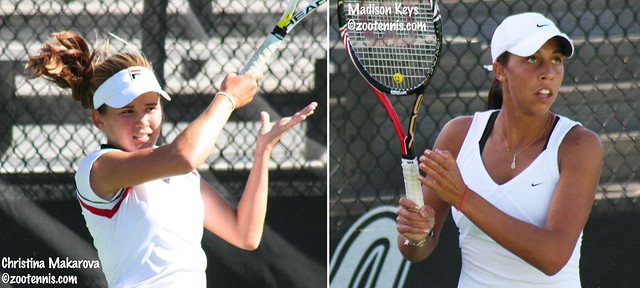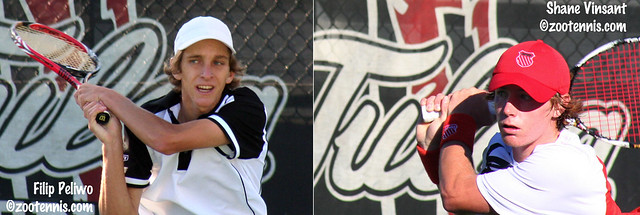
©Colette Lewis 2010--
Tulsa, OK--
Christina Makarova would have been happy to win one match at the ITF B1 Pan American Closed Championships. But after yet another upset Friday--a 6-2, 6-1 win over No. 4 seed Monica Turewicz--the 14-year-old from San Diego will play No. 3 seed Madison Keys for the girls singles title.
"My goal in this tournament was to win one match," said Makarova, who completely frustrated Turewicz with her counter-punching ability in Friday morning's quarterfinals at the Michael D. Case Tennis Center. "If I had lost this match, sure I would have been disappointed, but would have thought, I just got to the semis, what more can I ask for? But apparently, I can ask for more."
Makarova lost the first two games of her match against Turewicz, but then went on to take the next eight games on another warm and sunny day in Tulsa. With her ability to defend, a commitment not to miss and a willingness to hit dozens of moonballs per point if that's what is necessary, Makarova is extremely difficult to put away. The strategy of taking Makarova's looping shots out of the air can be effective, but Turewicz missed too many swinging volleys. And as is often the case against counterpunchers, and Turewicz is generally considered in that category herself, the other player begins to try to force the play, which leads to going for too much and making errors in the process. With Turewicz serving at 2-4 in the first set, having lost four straight games, she and Makarova engaged in what was certainly the longest point of the tournament. The ball had to have crossed the net 60 or 70 times, maybe more, but the strategy of trading moonballs with Makarova didn't work either, as Turewicz finally put the ball in the net.
The second set played out much the same as the first, and once Makarova held for a 3-1 lead after a long game in which Turewicz had three break points, Makarova's third straight win over a seeded player was secure, this one taking 90 minutes to complete.
Although she didn't know which of the other two semifinalists she would face, Makarova said she feared both Madison Keys and Lauren Davis.
"They scare me," said Makarova, who has never faced either player. "I know that I'm hard to win a point against, but they still scare me."
If there's a polar opposite to Makarova in junior tennis, it would be Keys. The 15-year-old from Boca Raton, Florida hits flat and hard, and doesn't change that approach no matter what the score or conditions. Third-seeded Keys and top seed Davis have trained together at the Evert Academy since Davis arrived early this year, but their only encounter in actual competition was in the 14s Winter Nationals, when Keys was 12 and Davis 14. Davis, who won the title in Tucson, beat Keys 6-0, 6-0 in the third round.
It looked as if Davis would get her second victory over Keys when she took the first set, but Keys bounced back to record a 2-6, 6-2, 6-2 win.
Keys had difficulty with her serve in the opening set, and was broken three times as a result. Davis is one of the few juniors capable of absorbing Keys' power and converting it to offensive shots of her own, and Keys, perhaps unaccustomed to seeing her big ground strokes rifled back at her, was forced into some errors. At 1-1 in the second set, Keys was down 0-40 on her serve, but saved all three break points. She went on to win 10 points in a row, breaking Davis at love, and wasn't broken again in the set.
Keys' forehand was simply too much for Davis near the end of the second set, and that didn't change in the third, even though Keys was broken at 1-1, with three forehand errors contributing to the break. She got it right back in the next game, with a forehand winner, and by the sixth game of the match, Davis was starting to struggle physically. After nine straight days of tennis at the Pro Circuit and ITF Junior Circuit level, Davis was tiring, and the cough that had bothered her all week was often heard.
"At the 4-2 game, she started looking a little out of breath and tired," said Keys, who did not play the Pro Circuit event in Williamsburg that Davis won last week. "With all those matches and all these matches, I imagine she's pretty worn down."
Davis began to try to end points quickly, often resorting to short shots to get Keys to the net. Occasionally the strategy would work, but Davis also netted several drop shots. Keys kept rolling on her serve, and Davis's usually impeccable footwork started to let her down. Davis was broken for the third time in the set in the final game, and Saturday's contrast in styles was set.
"I have to try to focus on playing my game, and not let her different paced balls give me a hard time," Keys said when asked about Makarova. "I will need to try to stay in the match the entire time. She has no pressure."

The boys final will feature No. 12 seed Filip Peliwo of Canada against No. 3 seed Shane Vinsant. Peliwo defeated No. 15 seed Alexios Halebian 6-2, 6-1, whom he had also beaten in the Junior Davis Cup North American qualifying in May.
"It can always go both ways," the 16-year-old Peliwo said of the psychology of a rematch. "On one side, you have the mental advantage of knowing you have beaten him before, and on the other side, he's even more motivated to go for the win. But definitely the match in May helped me know what to do against him. I had a plan, and I followed it."
Peliwo made almost no unforced errors, while Halebian was frequently misfiring. After holding serve for 2-2 in the first set, Halebian won only one more game.
"I think I played well, not really any fancy stuff, just making a lot of balls, playing aggressive when I had the chance, basically just forcing him to make the mistake," Peliwo said. "He was getting frustrated because he was missing quite a lot of balls today, and it was just kind of a snowball effect that got worse and worse for him."
Peliwo believes Vinsant, who beat No. 2 seed Bjorn Fratangelo 2-6, 6-3, 6-4, is a better matchup for him in the final, although he had not played either player. But if he's expecting another snowball to start rolling for him, Peliwo should note that Vinsant has lost the first set in his past two victories.
"I'm a guy who just gets ready for the next point," Vinsant said of his slow start, which saw him lose the last six games of the opening set. "I try to win every point, so I don't have to think, am I going to fight here? It's not a choice. I'm ready to go--it's a new set."
Vinsant's defense was outstanding throughout the match, and many of the potent forehands and backhands that Fratangelo threw at him would have certainly been winners against other players.
"I played a lot of good defense today," said Vinsant, a Texan who turns 17 later this month. "Bjorn's really offensive, so he'll force you to do that. I also got a little lucky that he missed a few shots."
Vinsant made the only break of the second set stand up, but despite taking a 4-1 two-break lead in the third set, Fratangelo wasn't done. He got one of the breaks back and held his own serve, forcing Vinsant to serve out the match at 5-4. Down 0-30, Vinsant was in danger, but Fratangelo's forehand let him down, with three errors on that side contributing to his loss of four straight points and the match.
Vinsant believes he has a good idea what to expect from Peliwo.
"I think I've got a pretty good game plan," Vinsant said. "He's solid from all over. I can't let him stand still a lot, I've got to keep him on the run."

In Saturday morning's single final, Vinsant will be playing for his second Pan American Closed title. He and partner Emmett Egger, who were finalists here in Tulsa last year, earned the championship with a 3-6, 6-3, 14-12 win over unseeded Chase Curry and Nolan Paige, saving three match points in the final tiebreaker. Curry and Paige had defeated No. 2 seeds Mitchell Krueger and Daniel McCall 7-6(5), 6-2 earlier in the semifinals Friday morning.
"We lost a similar match last year," Vinsant recalled of their 10-8 match tiebreaker loss to Brandon Burke of Jamaica and Darian King of Barbados. "So that made us want to get this more."
"Neither of us wanted to take second again," said Egger. "They were a tough team, did some things well, definitely hit a lot of good volleys. In the second set especially, we were able to come up with some good shots at some key moments."
Egger and Vinsant are no strangers to the winners circle in doubles. The top-seeded pair have now won three major tournaments in a row: International Grass Courts, USTA 18s Clay Courts and now the ITF B1 Pan American.
Keys is also still in the running for two Pan American titles. As the top seeds, she and Annie Mulholland will go for the girls doubles title on Saturday against the unseeded team of Whitney Kay and Turewicz. Both defeated Canadian teams in Friday afternoon's semifinals. Keys and Mulholland downed unseeded Francoise and Elisabeth Abanda 6-4, 2-6, 11-9, while Kay and Turewicz beat the No. 8 seeds Kimberley-Ann Surin and Carol Zhao 6-4, 6-4.
For complete draws, see the TennisLink site.




























